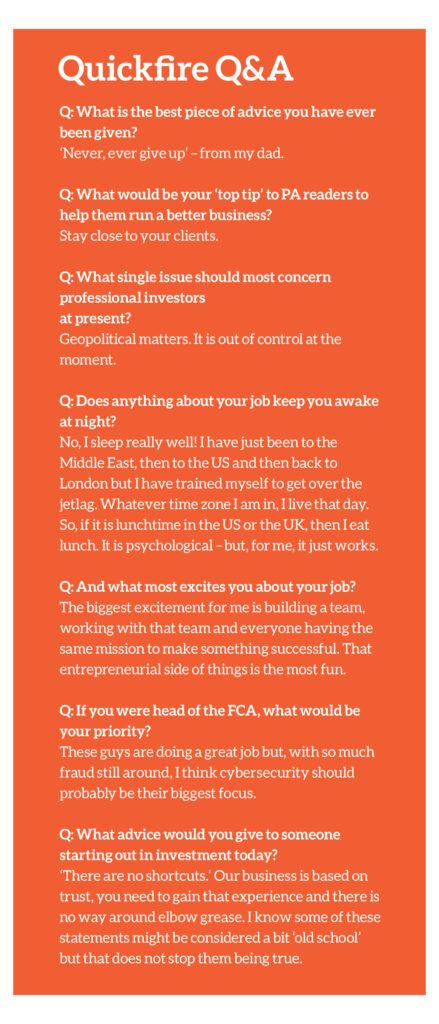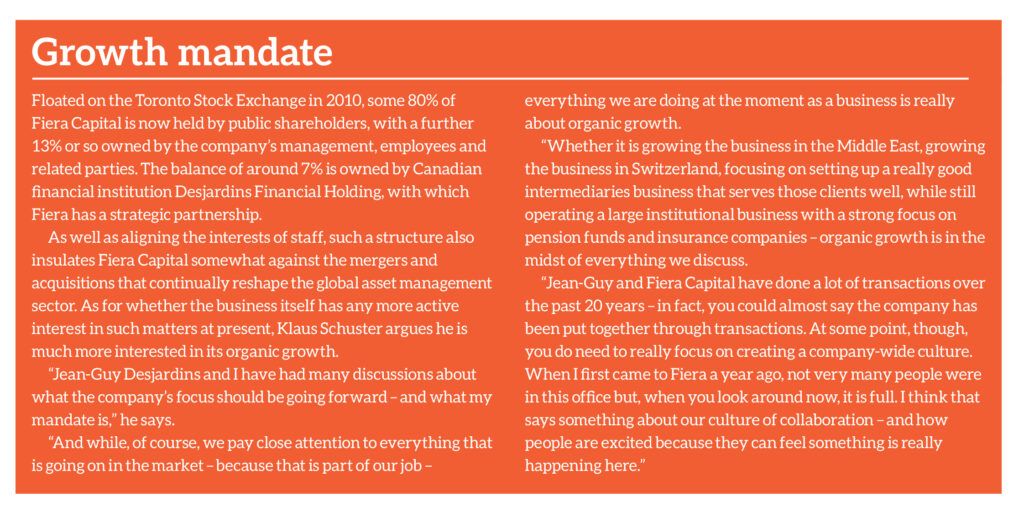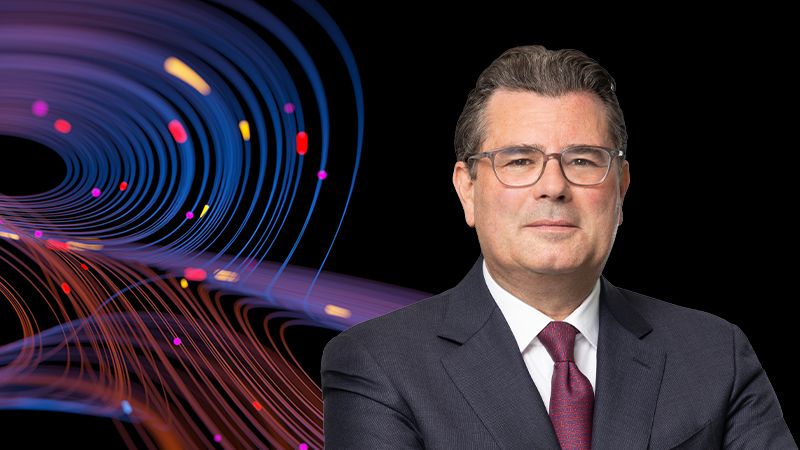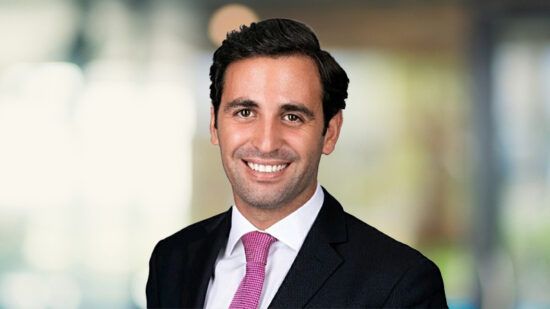The remit of Fiera Capital’s chief executive officer, EMEA, encompasses driving the Canadian asset manager’s strategy and business in Europe, the Middle East and Africa, as well as leading its distribution, consultant relations and marketing teams across those areas – yet for Klaus Schuster, who is approaching the first anniversary of his appointment to the role, the essence of all these responsibilities is a single idea.
“My job is basically to make sure the relationship between our existing and prospective clients and our investment teams is as good as it can be,” he says. “Everything else we do as a business should then support that relationship. It is a pretty simple thought but, if we can do that properly, we should end up taking our firm to the next level.”
Before his arrival at Fiera Capital last May, Schuster had been chief executive officer, EMEA, and global head of wealth management distribution at PineBridge Investments, which he had first joined in 2001. As it happens, that was the same year Jean-Guy Desjardins sold his principal shareholding in one asset management business he had co-founded and set about building another.
Fiera Capital, of which Desjardins is still chairman and global CEO, opened its headquarters in Montreal in 2003 and listed on the Toronto Stock Exchange seven years later. Perhaps unsurprisingly, given the global standing of the largest Canadian pension funds, the firm has had a strong focus on institutional clients but – along with insurance and wealth management – that is now one of three “big priorities”, as Schuster puts it.
Unified approach
“The institutional side was bigger than the wealth side but the wealth side is growing tremendously,” he continues. “That is why I really wanted a strong, unified approach to investing and to serve all our clients well. When I joined Fiera and talked to the team, it was clear to me we should have a greater focus on consultant relations and serve the consultants really well, because they are our door to the institutional business.
“Another strong area of focus is our own insurance business while our third priority – and this is in no particular order – is the wealth management space. We already have the necessary investment strategies in place to do this but we sometimes just need to add the appropriate product structures – a good example being the team we have in Dayton, Ohio, who manage some $5bn (£3.96bn) in US small and mid-cap equities.
“They have been working together for more than 20 years now but the strategy has never been sold into the EMEA wealth space. So we are putting it into a Ucits fund and now that will happen. That is where regional management can help – thinking about such things holistically – otherwise you can miss your chance. With some of these investment teams, you are almost doing the market a favour by making them accessible!
“So we see these, let’s call them intermediaries businesses – which, as well as the ‘classic’ wealth managers, would include the family offices, the private banks, the fund-of-fund managers, the unit-linked managers and the big IFA networks – as very important partners for Fiera and part of what I am doing at the moment involves restructuring our approach to how we service them.
“That basically means I will have a whole line of distribution that services those intermediaries across EMEA, led by Alain Meyer, who has just joined the company in Zurich, where we have now opened an office. That relationship between Switzerland, the UK and Singapore is so important because we want to be on the platforms of the global private banks and have some of them as partners – but to do that we need to service them well.”
Collaborative communication
Continuing his focus on the relationship between clients and investment teams, Schuster has been working to “connect the dots” across different parts of the company. “Since founding Fiera Capital 21 years ago, Jean-Guy Desjardins has bought a lot of boutiques,” he explains. “And these boutiques basically manage their own business – sometimes to the extent of having their own salespeople.
“When I came here, I was very interested in the overall platform, which I could see was really good on both the public market side and the private market side, so it was more about connecting the dots – finding distribution for everyone across those public and private assets and also making sure the investment teams talk to each other because, in the past, that has not happened as well as it could have done.

“Collaborative communication is so important because it can help trigger lots of good ideas – and we have already come a long way. We have, for example, implemented our ‘commercial investment council’, where all the investment teams sit with me on a regular basis and we talk about clients, about markets, about pricing and other trends and developments.
“That has not only led to better communication across the board, it has also brought the investment teams closer and made them a bit more accessible for distribution. I think everyone now sees that distribution and the investment teams work very closely together and, as a result, we are servicing the private market teams and the public market teams in a much more focused way.”
Clearly something of a balancing act is needed here: in essence, while enjoying the benefits of centralising certain functions of the different businesses that make up Fiera Capital, how has Schuster looked to ensure the boutique nature of the investment teams – which presumably made them so successful and thus a target of Fiera and Desjardins in the first place – persists?
“The boutique element and core strength of some of these investment teams is something we really want to keep because some of them – natural capital, say, or agriculture or timber – are unique strategies that require unique capabilities,” he replies. “There can be, for example, very little interaction with listed public companies so, almost by definition, their approach ensures they will be different.
“What I wanted to do, however, was make sure we all think as Fiera Capital, rather than as different businesses across different asset classes, because that helps enhance the overall brand. Clearly, when you go into any meeting and your brand is not known, that is a disadvantage – but we are now seeing our brand becoming better-known, while still, I believe, retaining the unique strength of certain teams.”
Entrepreneurial spirit
Since he mentions the subject, what does Schuster believe underpins the Fiera Capital brand? “One very special aspect of Fiera is it was founded by an entrepreneur,” he replies. “Jean-Guy is still in the business and I work closely with him because we want to keep that entrepreneurial spirit. I have always had the strong conviction that you do not manage a business yourself – you build a business and then you run it with a team.
“And you have to keep these entrepreneurial features – especially when you are a smaller asset manager like us – I mean, we are $122.6bn, with a really unique platform on both the private markets and public markets sides, but we are not one of the giants of the industry. So I think you need to focus on your strengths – and one of our strengths is we can move quickly.
“We have made significant decisions in the months since I joined the business and we have already executed on them. As I said, we recently opened an office in Switzerland because we see that as one of the important hubs for the wealth business we want to focus on more – and a week later we opened our first office in the Middle East, in Abu Dhabi, to focus on serving the sovereign wealth fund as well as other players in the region.
“We know the Middle East well as investors and it is arguably the fastest-growing EMEA region – so we came up with a plan, we discussed it in the global management committee and we executed on it. And that is entrepreneurship. If we analyse something, plan something and discuss it, then execution is really important. And we did that quickly – much, much quicker than would likely happen in the really big organisations.”
Finally, what sorts of businesses does Schuster see emerging as the winners and losers of asset management over the coming decade – and why? “As I said before, if we understand that the relationship between investment teams and existing and prospective clients is the most important thing – and that everything else we do should support this – then you can build a successful asset management business,” he replies.
“More philosophically, if you lose touch with clients – and you see this happening all over the world, where people just centralise services and run the business out of one place, without really being in front of the client – then you are missing the whole point. As asset managers, our livelihood centres on that relationship of trust we have with our clients and how we serve them. Whether the client is a sovereign wealth fund, an asset management platform, a wealth manager or whatever, that is our job and we need to make every effort – as we are doing here – to be on the ground in front of people.”


This article originally appeared in the April issue of Portfolio Adviser







